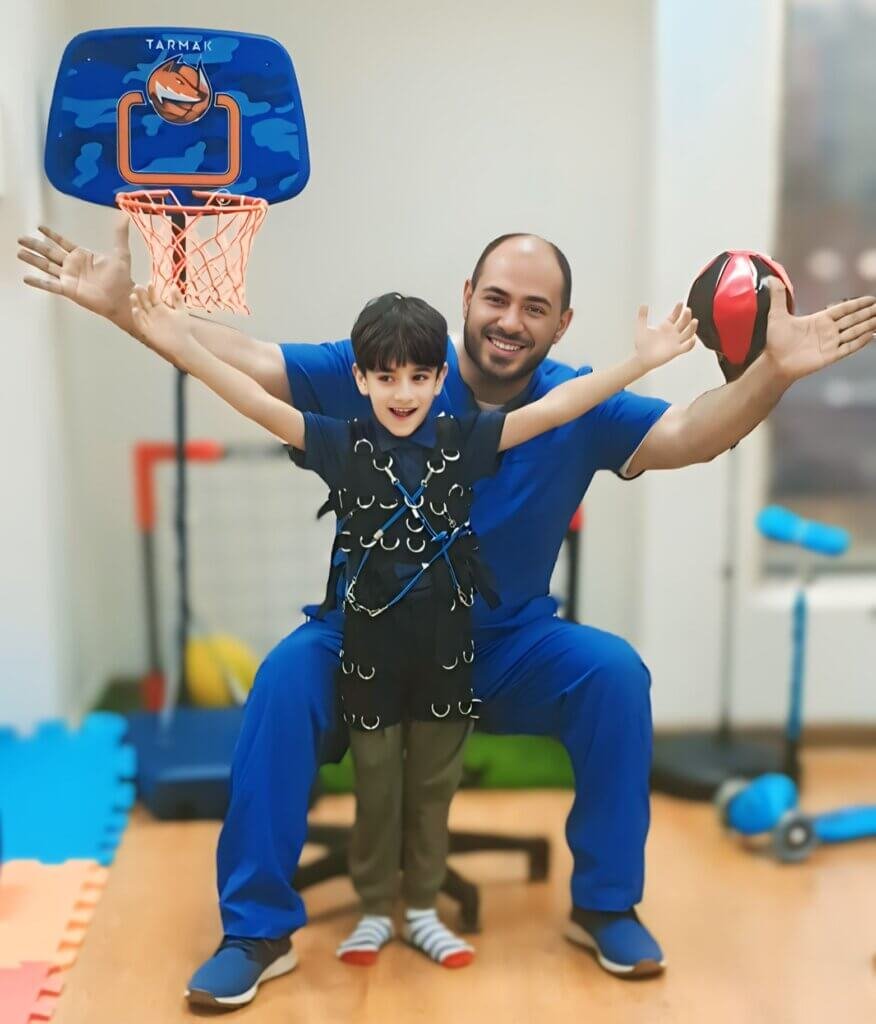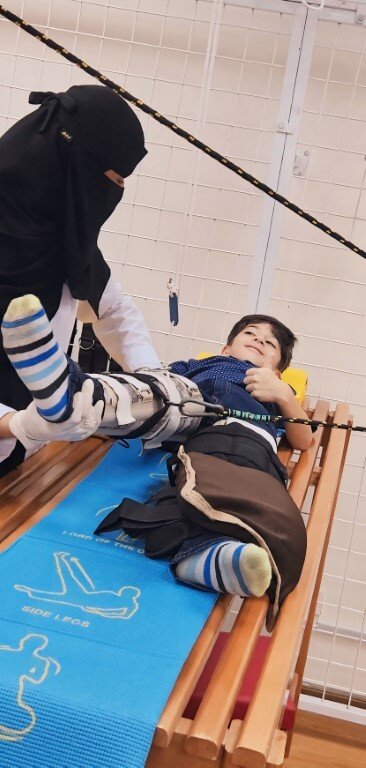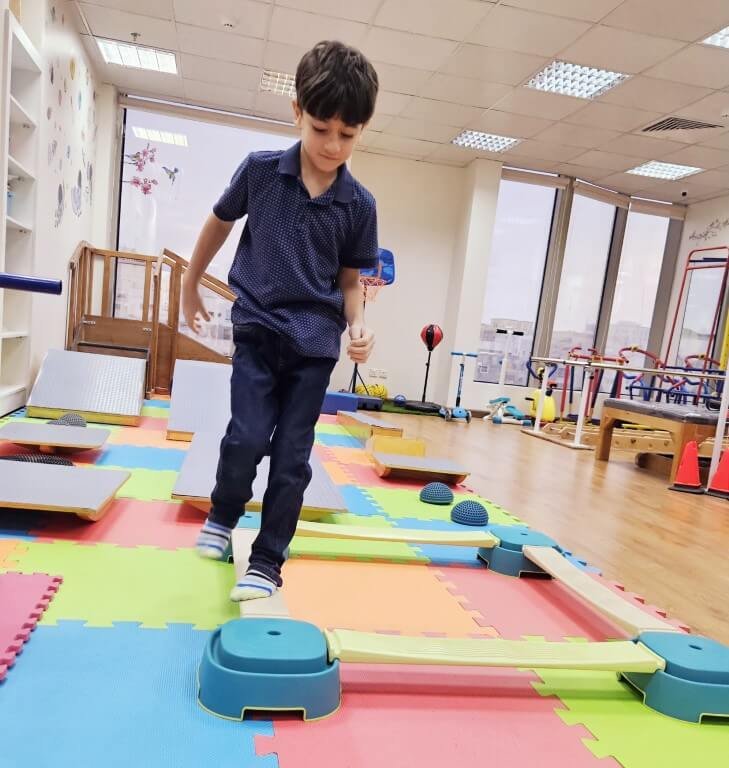Pediatric physical therapy is a medical specialty aimed at helping children achieve maximum independence in their daily lives. It focuses on developing motor, cognitive, sensory, and social skills that children need for learning, playing, and interacting with their environment.
Different Types of Pediatric Physical Therapy
1 – Pediatric Neurological Physical Therapy:
Neurological physical therapy helps children who suffer from certain neurological conditions that may cause physical difficulties such as weakness, balance disorders, muscle spasms, and limited movement. This type of therapy aims, through the use of a variety of treatments, to improve children's potential and enhance their physical functions and mobility through rehabilitation and therapy.
2 – Developmental Pediatric Physical Therapy
As the name suggests, pediatric developmental physical therapy focuses on addressing issues related to a child's growth. This type of physical therapy is recommended for children who experience functional difficulties and do not develop at the same rate as their peers of the same age. There can be many reasons for developmental delays, but various physical therapy techniques can assist in the child's development.
3 – Pediatric Musculoskeletal Physical Therapy:
Pediatric musculoskeletal physical therapy is a type of therapy that addresses issues related to bones, muscles, and joints in children. While it is often assumed that children don't face such problems, the reality is quite different. These conditions can significantly impact growth, function, and gait during early years. Injuries resulting from sports activities, overtraining, and abnormal walking patterns often lead to these issues. Common musculoskeletal problems seen in active children include Osgood-Schlatter syndrome, Sever's disease, knee pain, and lower back pain.
4 – Rehabilitation and Recovery:
Pediatric physical therapy can help speed up the recovery of children who have suffered an injury, undergone surgery, or experienced trauma. Physical therapists can assist children in accelerating the healing process, reducing swelling and joint movement limitations, and ensuring the child safely and confidently returns to activity through prescribed exercises and manual therapies.
The Importance of Physical Therapy in the Different Stages of a Child's Development
-
Postnatal Stage
- Improving breastfeeding: It helps position the baby correctly during feeding, which contributes to the proper development of the jaw and tongue.
- Strengthening neck and back muscles: It helps strengthen the neck and back muscles, allowing the child to lift their head and begin crawling.
- Regulating muscle tone: It helps regulate muscle tone in the body, reducing tension and promoting relaxation.
-
Early Childhood Stage:
- Developing basic motor skills: It helps the child develop fundamental movement skills such as crawling, sitting, standing, and walking.
- Improving balance and coordination: It helps enhance balance and coordination, allowing the child to engage in play and participate in daily activities.
- Treating motor developmental delays: It helps children with motor developmental delays catch up with their peers.
-
Late Childhood Stage:
- Enhancing athletic performance: It helps children who participate in sports improve their performance and reduce the risk of injuries.
- Treating sports injuries: It helps in faster and more effective recovery from sports-related injuries.
- Improving posture: It helps correct any postural issues, such as scoliosis or back curvature.
Who is a Pediatric Physical Therapist?
A pediatric physical therapist is a specialist in evaluating and treating conditions that affect a child's movement and daily activity. They work to improve the child's motor and functional abilities, providing the skills needed for independence and participation in daily life. The pediatric physical therapist is a key partner in a child's developmental journey, helping to empower the child to achieve maximum independence and integration into society. Through comprehensive assessment and individualized treatment plans, the pediatric physical therapist helps the child overcome challenges and reach their goals.
How are physical therapy sessions conducted?
Physical therapy sessions are conducted through a variety of activities and techniques tailored to meet each child's individual needs. These activities include:
- Games: Games are used to train the child in new skills in a fun and motivating way.
- Sensory-motor activities: These aim to stimulate various senses to improve the child's body awareness.
- Movement and walking exercises: Special exercises are used to strengthen muscles and improve balance and coordination.
- Balance exercises: Balance equipment is used to stimulate the child's motor awareness and enhance sensory-motor patterns.
- Horse riding simulators: These are used to increase body flexibility, boost confidence, enhance the child's body awareness, and improve motor perception.
What is the role of a pediatric physical therapist?
The role of a pediatric physical therapist includes the following:
- Assessment: The therapist evaluates the child's health condition, identifies strengths and weaknesses in motor performance, and diagnoses any motor developmental delays or disorders affecting movement.
- Developing a treatment plan: The therapist creates an individualized treatment plan tailored to the child's needs and goals, incorporating a range of techniques and exercises to improve movement and physical functions.
- Implementing the treatment program: The therapist is responsible for carrying out the treatment plan with the child, which may include muscle-strengthening exercises, joint flexibility exercises, improving balance and coordination, and using assistive devices when necessary.
- Education and guidance: The therapist teaches the child and their family how to perform exercises at home, providing advice and guidance to maximize the benefits of the therapy.
- Collaboration with the healthcare team: The therapist works in cooperation with doctors and other therapists to ensure the best possible care for the child.
When should a child visit a pediatric physical therapist?
A pediatric physical therapist should be consulted in the following cases:
1. Failure to reach key developmental milestones: If the child does not achieve essential motor developmental stages within the first 12 months of life.
2. Preference for one side of the body: If the child favors using one side of their body or consistently tilts their head to one side.
3. Abnormal body posture: If the child exhibits poor posture while sitting, sleeping, standing, or walking.
4. Muscle weakness: If the child experiences muscle weakness, limpness, or an inability to roll over or lift their head.
5. Balance issues: If the child has trouble with balance, leading to unsteadiness or frequent falls.
6. Abnormal joint movement: If the child's joint movement is either limited or excessive.
7. Diagnosis of certain conditions: Such as torticollis, cerebral palsy, Down syndrome, or Erb's palsy.
8. Balance or coordination issues: If the child experiences difficulties with balance or motor coordination.
Physical therapy should be administered by a licensed, certified, and experienced physical therapist, preferably holding a professional practice certificate from the Medical Specialties Board.
What are the benefits a child gains from physical therapy?
1. Improvement of motor skills: Such as sitting, crawling, walking, and hand-eye coordination.
2. Development of sensory skills: Such as touch, hearing, and vision.
3. Enhancing social skills: Such as interacting with others and participating in group play.
4. Increasing independence: Helping the child perform daily tasks independently.
5. Boosting self-confidence: Developing a sense of achievement and the ability to reach goals.
Pediatric Physical Therapy Services at Free to Move Center
Pediatric physical therapy is a medical specialty aimed at assessing and treating conditions that affect a child's movement and activity. It seeks to improve the child's ability to crawl, walk, change body positions, move, play, and interact with their environment. This is achieved through a range of therapeutic techniques and exercises tailored to each child, with the goal of enhancing their motor independence and physical development.













